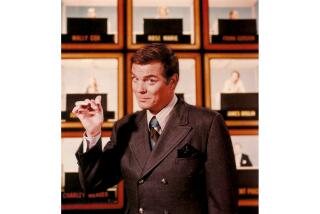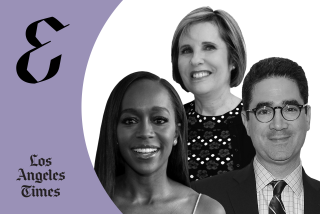Appreciation: Penny Marshall broke ground as a director, but on TV she was loved as ‘Laverne’
In terms of historical importance, Penny Marshall’s career as a film director — her “Big” was the first picture by a woman to gross more than $100 million at the U.S. box office — overshadows her work as an actress, mostly in television. Yet millions unaware that she ever directed a movie will remember her fondly as Laverne DeFazio, friend, roommate and coworker to Cindy Williams’ Shirley Feeney in the sitcom “Laverne & Shirley,” which ran on ABC from 1976 to 1983. Many will remember her as well as Oscar Madison’s secretary Myrna on “The Odd Couple,” and some for a few appearances on “The Mary Tyler Moore Show,” or as a regular in the short-lived “Paul Sand in Friends and Lovers.” Before and after “Laverne,” with greater and lesser regularity, until her final appearance, in 2016, on an episode of the rebooted “Odd Couple,” Marshall remained a television presence.
Although her mother ran a dance school where Marshall herself taught tap, and her father directed industrial films, and her brother Garry Marshall wrote for the sitcoms of Lucille Ball, Danny Thomas and Dick Van Dyke before developing “The Odd Couple” and creating “Happy Days” — and though she was named Carole Penny Marshall for Carole Lombard — by her own account, she walked in sideways to acting.
She had majored in math and psychology at the University of New Mexico, got pregnant there, got married, got divorced and worked as a secretary, the career she envisioned for herself in her high school yearbook. (Her daughter, Tracy, was later adopted by Marshall’s second husband, Rob Reiner, whom she married in 1971.) Notwithstanding some performing with the Albuquerque Civic Light Opera, “I didn’t plan on being in the business,” she said in a 2013 video interview for the Archive of American Television.

She left Albuquerque to join her brother in Los Angeles. Garry, who thought she was “sort of funny,” encouraged her to take some acting classes — she studied with Harvey Lembeck and Jeff Corey, which is to say, the cream of the crop. After a one-word part in an episode of “That Girl” earned her more money than a week of work as a temp typist, she switched careers. “The Odd Couple” was her first regular gig; she is sweet and eccentric in it, and she does a lot with a little.
Laverne and Shirley were born as guest characters on “Happy Days,” 1950s-style wild girls on a double date with Fonzie (Henry Winkler) and Richie (Ron Howard). Popular with viewers, they returned for several more episodes before being spun off into their own series, Marshall’s first and only starring role.
Bottle-cappers in a Milwaukee brewery, living in a basement apartment, the roommates, who were somewhat improper by “Happy Days” standards, were recast to make them more family-friendly: “We were the slutty girls who became virgins,” as Marshall put it, though it seems clear that Laverne, in a way that the series never deigned to make explicit, was, within unexpressed limits, sexually forward. (“A little boy crazy,” Marshall called her.)
It’s easy to dismiss “Laverne & Shirley,” which debuted as the No. 1 series on television, as hectic fluff, a Lucy-and-Ethel knockoff, especially given its later, decadent seasons. But at its best, there is something surprisingly natural in its staging and performance, a blue-collar comedy whose characters seem, most of them, much of the time — I make exception, of course, for the farcical two stooges, Michael McKean’s Lenny and David L. Lander’s Squiggy — pretty real. That Bronx accent was all Marshall’s.
Williams was, in conventional terms, the cute one. Marshall often demeaned her own looks; early in her career, she played the nominally less attractive opposite to Farrah Fawcett’s beauty in a Head & Shoulders shampoo commercial. But I found her the attractive one, even beautiful: lanky, with a striking profile and wide-set eyes, she was Italian on her father’s side. Where Shirley is proper, Laverne is loose; where Williams was girlish, Marshall was womanly.
(I also constantly see something of Harpo Marx in her — the most physical and feminine Marx Brother. The thought doesn’t seem out of place.)
Marshall’s later television appearances, which included visits to “Entourage,” “Bones,” “Portlandia” and “Mulaney,” could be self-referential; she would play herself, or something that played off her earlier roles, as when she reunited with Williams in a 2013 episode of Nickelodeon’s teen sitcom “Sam & Cat.” (In the physical spirit of “Laverne & Shirley,” there was boxing.) Her 2016 “Odd Couple” appearance, again with Williams — as well as with “Happy Days” cast members Howard, Marion Ross, Anson Williams and Don Most — was in tribute to her late brother.
The dominant tone of her own accounts of her career is one of self-deprecation. Of her first directing experience, on “Laverne & Shirley”: “By the sixth, seventh year, who wants to direct this week — the script girl, first AD, the camera coordinator, whoever. How many doors can you come through? There’s one door.” (This was a story she repeated nearly word for word.) On her TV guest shots: “I was in an episode of ‘Mork and Mindy,’ I was in an episode of ‘Taxi,’ I was in an episode of ‘Bosom Buddies ‘ — you name it, if it was on the lot, I ran from my stage to their stage. They said, ‘You’ll be yourself.’ What else am I? This is what I am.”
Perhaps there is something in that that speaks to what makes her work still a joy to watch, what gives it life, what makes it real: She was who she was.
ALSO
FROM THE ARCHIVES: With the success of 1988’s ‘Big’ Penny Marshall’s career turned a corner
Follow Robert Lloyd on Twitter @LATimesTVLloyd
More to Read
The complete guide to home viewing
Get Screen Gab for everything about the TV shows and streaming movies everyone’s talking about.
You may occasionally receive promotional content from the Los Angeles Times.







